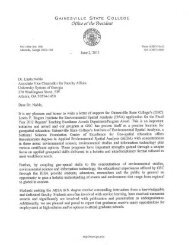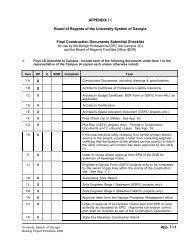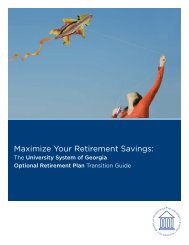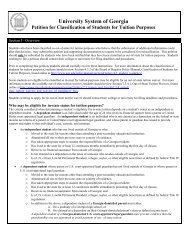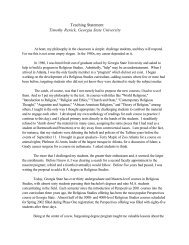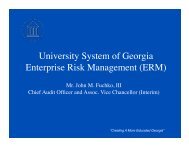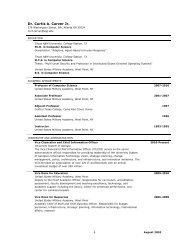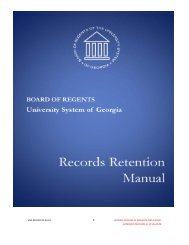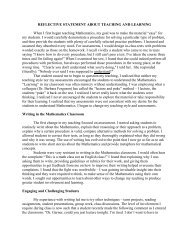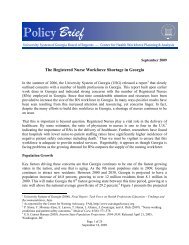66912 Federal Register / Vol. 75, No. 209 / Friday, October 29, 2010 / Rules and RegulationsWReier-Aviles on DSKGBLS3C1PROD with RULES2statistical analysis that determineswhether an applicant’s record or aparticular item should be verified due tothe likelihood <strong>of</strong> error includes factorsbeyond those that are used to calculatethe EFC. We do not believe that thenumber <strong>of</strong> these instances will besignificant.Changes: None.Comment: One commenter indicatedthat the proposed regulations areconfusing with respect to the handling<strong>of</strong> overpayments due to interimdisbursements made after an applicanthad been selected for verification, andthe handling <strong>of</strong> overpayments due todisbursements made before an applicantwas selected for verification.Discussion: We agree with thecommenter that proposed § 668.59(b),(c), and (d) may be confusing becausethese paragraphs do not clearly statehow institutions must handle anoverpayment that is the result <strong>of</strong> interimdisbursements made after the applicantis selected for verification. Further,proposed § 668.59(b), (c), and (d) mayalso be confusing because theseparagraphs do not clearly state howinstitutions must handle anoverpayment that is the result <strong>of</strong> adisbursement that is made before theapplicant is selected for verification butthat is later discovered to be anoverpayment. While proposed§ 668.59(b), (c), and (d) was intended todescribe how to handle an overpaymentin both <strong>of</strong> these situations if theapplicant is receiving aid under thesubsidized student financial assistanceprograms, we believe that furtherchanges are needed so that this sectionclearly states that an institution mustcomply with both the procedures in§ 668.61 for an interim disbursementthat is determined later to be anoverpayment, and the appropriateoverpayment requirements in theapplicable program regulations foroverpayments discovered duringverification that were due todisbursements made prior to a studentbeing selected for verification.Changes: We have revised § 668.59(b),which covers the consequences <strong>of</strong> achange in an applicant’s FAFSAinformation as the result <strong>of</strong> verificationfor the Federal Pell Grant Program, toprovide that for purposes <strong>of</strong> the FederalPell Grant Program the institution mustfollow the procedures in § 668.61 forhandling overpayments due to interimdisbursements, and the procedures in§ 690.79 for overpayments that are notthe result <strong>of</strong> interim disbursements.We have also revised § 668.59(c),which covers the consequences <strong>of</strong> achange in an applicant’s FAFSAinformation as the result <strong>of</strong> verificationfor the subsidized student financialassistance programs, excluding theFederal Pell Grant Program. Section668.59(c) also covers the DirectSubsidized Loan Program that washandled originally in proposed§ 668.59(d). As revised, § 668.59(c) nowprovides that the institution must followthe procedures in § 668.61 for handlingoverpayments due to interimdisbursements, including for the FWSProgram. Further, § 668.59(c) nowprovides that the institution must followthe procedures in § 673.5(f) for handlingoverpayments that are not the result <strong>of</strong>interim disbursements under theFederal Perkins Loan or FSEOGprograms. Finally, we have revised§ 668.59(c) to also provide that theinstitution must follow the proceduresin § 685.303(e) for handlingoverpayments that are not the result <strong>of</strong>interim disbursements under the DirectSubsidized Loan Program.The content in § 668.59(d) has beenincorporated into paragraph § 668.59(c).Deadlines for SubmittingDocumentation and the Consequences<strong>of</strong> Failing To Provide Documentation(§ 668.60(c)(1))Comment: Two commentersconcurred with the provision underproposed § 668.60(c)(1) that allows astudent who completes verificationwhile the student is no longer enrolledto be paid based on the valid SAR orvalid ISIR. These commenters statedthat this approach was preferable tocurrent § 668.60(c)(1), which providesthat the student is paid based on thehigher <strong>of</strong> the two EFCs if the studentsubmits a valid SAR or valid ISIR whilethe student is no longer enrolled. Underthat approach, the student wouldreceive the lesser amount <strong>of</strong> a FederalPell Grant.Discussion: We appreciate thecommenters’ support.Changes: None.Comment: One commenterencouraged the <strong>Department</strong> to allowinstitutions to implement § 668.60(c)(1)prior to the 2011–12 award year.Discussion: While we appreciate thecommenter’s desire to implement thisprovision prior to the 2011–12 awardyear, we believe that allowing earlyimplementation would interfere withpolicies already in place for the 2010–11 award year, and how that mayimpact aid already disbursed, i.e., howto account for aid disbursed for asummer term that was assigned to theprior award year. As noted earlier inthis preamble, the changes to subpart E<strong>of</strong> part 668, including § 668.60, willbecome effective on July 1, 2012, so thatVerDate Mar2010 14:10 Oct 28, 2010 Jkt 223001 PO 00000 Frm 00082 Fmt 4701 Sfmt 4700 E:\FR\FM\29OCR2.SGM 29OCR2it will be implemented beginning withthe 2012–13 award year and forward.Changes: None.Recovery <strong>of</strong> Funds (§ 668.61)Comment: One commenter supportedthe proposed changes to § 668.61.Another commenter noted that § 668.61should only address recovery <strong>of</strong> fundsin the event <strong>of</strong> overpayments resultingfrom interim disbursements—notoverpayments that are not the result <strong>of</strong>interim disbursements. This commenterindicated that this section also containserroneous cross-references. In addition,this commenter stated that this sectionshould provide information on how totreat overpayments made under theFWS Program as interim disbursementsbecause the student must be paid for allhours worked.Discussion: Section 668.61 is abouthandling the recovery <strong>of</strong> overpaymentsdue to interim disbursements. Therecovery <strong>of</strong> overpayments that are notthe result <strong>of</strong> interim disbursements,including overpayments that result fromdisbursements made before an applicantwas selected for verification and laterafter selection for verification theapplicant’s SAR and ISIR must becorrected, are addressed by theappropriate overpayment requirementsin the applicable program regulations.We agree with the commenter that some<strong>of</strong> the cross-references in proposed§ 668.61 need to be corrected.We also agree with the commenterthat it would be helpful for § 668.61 toprovide details on how to handle therecovery <strong>of</strong> overpayments that occurfrom interim disbursements for studentsemployed under the FWS Program.Under § 668.58(a)(2)(ii), an institution isallowed to employ an applicant underthe FWS Program for the first 60consecutive days after the student’senrollment in that award year prior toverification, if the institution does nothave reason to believe that anapplicant’s FAFSA information isinaccurate. If an FWS overpaymentoccurs due to this interim disbursement,the institution must follow theprocedures in § 668.61(b). We haverevised § 668.61(b) to clarify that theinstitution must attempt to adjust theapplicant’s other financial aid toeliminate the overpayment due to aninterim disbursement under the FWSProgram. This revised § 668.61(b)provides that, if the institution is unableto eliminate the overpayment byadjusting the applicant’s other financialaid, the institution must reimburse theFWS Program account by makingrestitution from its own funds. Theapplicant must still be paid for all workperformed under the Federal labor laws.
Federal Register / Vol. 75, No. 209 / Friday, October 29, 2010 / Rules and Regulations66913WReier-Aviles on DSKGBLS3C1PROD with RULES2Because the applicant was employed,the applicant must be placed on theinstitution’s own payroll account andall required employer contributions forsocial security, workers’ compensation,or any other welfare or insuranceprogram, must still be paid by theinstitution because this applicant wasan employee.In addition, the institution is allowedunder § 668.58(a)(3) to employ a studentunder the FWS Program for the first 60consecutive days prior to receiving thecorrected valid SAR or valid ISIR if,after verification, it determines that anapplicant’s information will not changethe amount that the applicant wouldreceive under that program. In§ 668.61(c), we require that if an FWSoverpayment occurs because theinstitution does not receive the validSAR or valid ISIR reflecting correctionswithin the established deadline dates,the institution must reimburse the FWSProgram account by making restitutionfrom its own funds. In § 668.61(c), weclarify that the student must still bepaid for all work performed under theinstitution’s own payroll account andthe institution must still handle allemployer requirements.Changes: We have revised § 668.61,including the section heading, to clarifythat this section is about handlingoverpayments due to interimdisbursements made under § 668.58. Wehave also corrected the cross-referencesin this section. In addition, we haverevised § 668.61(b) to provide specificprocedures for recovering funds fromany FWS overpayment that results froman interim disbursement made beforeverification is completed. We haverevised § 668.61(c) that describes theprocedures for handling overpaymentsdue to an allowable interimdisbursement <strong>of</strong> subsidized studentfinancial assistance, including anydisbursement from FWS employment,before the institution receives the validSAR or valid ISIR reflecting thecorrections. Section 668.61(c) nowmakes it clear that the applicant muststill be paid for all work performedunder the institution’s own payrollaccount.Misrepresentation (Subpart F—§§ 668.71 Through 668.75)GeneralComment: A significant number <strong>of</strong>commenters generally or fundamentallysupported the proposed regulations insubpart F <strong>of</strong> part 668. Severalcommenters stated that the proposedregulations on misrepresentation reflectan excellent, much-neededimprovement over current regulatorylanguage and that they will significantlyenhance the <strong>Department</strong>’s ability toaddress deceptive practices thatcompromise the ability <strong>of</strong> students tomake informed choices aboutinstitutions and the expenditure <strong>of</strong> theirresources on higher education. Onecommenter agreed, in particular, withproposed §§ 668.72 and 668.73, whichensure that all students have access andtransparent information about theireducational program and its cost. Thiscommenter noted that accuratedisclosures are needed in order toprotect students, especially in light <strong>of</strong>the many documented instances inwhich students have had theirexpectations regarding postsecondaryeducation outcomes (e.g., completeddegrees, good jobs and high salaries) notmet with success but with failure andmountains <strong>of</strong> debt instead. Onecommenter stated that the proposedregulations on misrepresentationprovide additional protections againstmisleading and overly aggressiveadvertising and marketing tactics.Another commenter strongly supportedthe proposals and stated that integrity inhow institutions present themselves iskey to ensuring students are not victims<strong>of</strong> false promises or misunderstandingwhen making a decision about highereducation. Finally, we received manycomments that supported the<strong>Department</strong>’s mission <strong>of</strong> helpingstudents make sound decisions andmaintaining the integrity <strong>of</strong> the title IV,HEA programs but expressed concernabout some <strong>of</strong> the specific language.Discussion: We appreciate thecommenters’ support. We address thecomments and concerns on specificlanguage in the relevant sections thatfollow.Changes: None.Comment: Many commentersstrenuously opposed the proposedrevisions to the misrepresentationregulations in subpart F <strong>of</strong> part 668.Some commenters argued that, becausemisrepresentation is an issue moreappropriately addressed by the FederalTrade Commission (FTC), the<strong>Department</strong> should have adopted inthese regulations the language from theFTC guidelines so that those guidelineswould be applicable to all institutionsparticipating in the title IV, HEAprograms. These commenters noted thatfor-pr<strong>of</strong>it institutions are already subjectto the FTC guidelines and that theresults <strong>of</strong> that guidance have servedtheir students well and that othersectors <strong>of</strong> higher education should besubject to the FTC guidelines as well.Several commenters stated thatstudents would be confused by theproposed regulations dealing withVerDate Mar2010 14:10 Oct 28, 2010 Jkt 223001 PO 00000 Frm 00083 Fmt 4701 Sfmt 4700 E:\FR\FM\29OCR2.SGM 29OCR2misrepresentation. Specifically, thecommenters expressed concern thatbecause institutions discloseinformation to many parties, includingaccrediting agencies, the <strong>Department</strong>,current and prospective students, andthe general public, information requiredto be disclosed under the title IV, HEAprogram regulations is complex and notalways easy to understand. Therefore,the commenters argued that studentswill not be able to make informeddecisions about which institution toattend because, under the title IV, HEAprogram regulations, they will beprovided different statistics and willhave difficulty understanding them.One commenter expressed concernthat while the education community isin need <strong>of</strong> clear guidance on ethicalpractices and the proposed regulationsare well-intended, they are too vagueand subjective. A few commenters urgedthe <strong>Department</strong> not to adopt theproposed regulations as final unlessthey are significantly clarified.Finally, one group <strong>of</strong> commentersstated that the proposed changes tosubpart F <strong>of</strong> part 668 are unfair to forpr<strong>of</strong>itschools. Some commentersappeared to believe that the revisionsreflected in proposed subpart F <strong>of</strong> part668 would only apply to for-pr<strong>of</strong>itschools.Discussion: During the negotiationsthat were held during the months <strong>of</strong>November 2009 through January 2010,we discussed whether to adopt the FTCguidelines in our misrepresentationregulations. Some non-Federalnegotiators strongly opposed adoptingthe FTC guidelines in the <strong>Department</strong>’sregulations because doing so, theyargued, would be duplicative andheavy-handed.The FTC only has jurisdiction overfor-pr<strong>of</strong>it entities, and those entities arealready subject to the FTC guidelines.The FTC guidelines do not apply todegree-granting institutions, and webelieve it would not be appropriate toadopt the FTC guidelines wholesale.Instead, we have reviewed theguidelines carefully and incorporatedonly those that we determined areappropriate for inclusion in ourregulations (i.e., those that we believeshould be applicable to all eligibleinstitutions participating in the title IV,HEA programs).With regard to the commenters whoexpressed concern for students beingconfused by these regulations, we notethat the proposed regulations apply toinstitutions participating in the title IV,HEA programs and not to students.Because students are not the intendedaudience for these regulations, we donot believe that students will be
- Page 1 and 2:
Friday,October 29, 2010Part IIDepar
- Page 3 and 4:
Federal Register / Vol. 75, No. 209
- Page 6 and 7:
66836 Federal Register / Vol. 75, N
- Page 8 and 9:
66838 Federal Register / Vol. 75, N
- Page 10 and 11:
WReier-Aviles on DSKGBLS3C1PROD wit
- Page 12 and 13:
66842 Federal Register / Vol. 75, N
- Page 14 and 15:
66844 Federal Register / Vol. 75, N
- Page 16 and 17:
WReier-Aviles on DSKGBLS3C1PROD wit
- Page 18 and 19:
66848 Federal Register / Vol. 75, N
- Page 20 and 21:
66850 Federal Register / Vol. 75, N
- Page 22 and 23:
WReier-Aviles on DSKGBLS3C1PROD wit
- Page 24 and 25:
66854 Federal Register / Vol. 75, N
- Page 26 and 27:
WReier-Aviles on DSKGBLS3C1PROD wit
- Page 28 and 29:
66858 Federal Register / Vol. 75, N
- Page 30 and 31:
66860 Federal Register / Vol. 75, N
- Page 32 and 33: 66862 Federal Register / Vol. 75, N
- Page 34 and 35: 66864 Federal Register / Vol. 75, N
- Page 36 and 37: 66866 Federal Register / Vol. 75, N
- Page 38 and 39: WReier-Aviles on DSKGBLS3C1PROD wit
- Page 40 and 41: WReier-Aviles on DSKGBLS3C1PROD wit
- Page 42 and 43: 66872 Federal Register / Vol. 75, N
- Page 44 and 45: WReier-Aviles on DSKGBLS3C1PROD wit
- Page 46 and 47: WReier-Aviles on DSKGBLS3C1PROD wit
- Page 48 and 49: WReier-Aviles on DSKGBLS3C1PROD wit
- Page 50 and 51: 66880 Federal Register / Vol. 75, N
- Page 52 and 53: WReier-Aviles on DSKGBLS3C1PROD wit
- Page 54 and 55: 66884 Federal Register / Vol. 75, N
- Page 56 and 57: 66886 Federal Register / Vol. 75, N
- Page 58 and 59: WReier-Aviles on DSKGBLS3C1PROD wit
- Page 60 and 61: WReier-Aviles on DSKGBLS3C1PROD wit
- Page 62 and 63: WReier-Aviles on DSKGBLS3C1PROD wit
- Page 64 and 65: WReier-Aviles on DSKGBLS3C1PROD wit
- Page 66 and 67: WReier-Aviles on DSKGBLS3C1PROD wit
- Page 68 and 69: WReier-Aviles on DSKGBLS3C1PROD wit
- Page 70 and 71: WReier-Aviles on DSKGBLS3C1PROD wit
- Page 72 and 73: 66902 Federal Register / Vol. 75, N
- Page 74 and 75: WReier-Aviles on DSKGBLS3C1PROD wit
- Page 76 and 77: WReier-Aviles on DSKGBLS3C1PROD wit
- Page 78 and 79: 66908 Federal Register / Vol. 75, N
- Page 80 and 81: WReier-Aviles on DSKGBLS3C1PROD wit
- Page 84 and 85: WReier-Aviles on DSKGBLS3C1PROD wit
- Page 86 and 87: 66916 Federal Register / Vol. 75, N
- Page 88 and 89: WReier-Aviles on DSKGBLS3C1PROD wit
- Page 90 and 91: WReier-Aviles on DSKGBLS3C1PROD wit
- Page 92 and 93: WReier-Aviles on DSKGBLS3C1PROD wit
- Page 94 and 95: 66924 Federal Register / Vol. 75, N
- Page 96 and 97: WReier-Aviles on DSKGBLS3C1PROD wit
- Page 98 and 99: 66928 Federal Register / Vol. 75, N
- Page 100 and 101: WReier-Aviles on DSKGBLS3C1PROD wit
- Page 102 and 103: 66932 Federal Register / Vol. 75, N
- Page 104 and 105: WReier-Aviles on DSKGBLS3C1PROD wit
- Page 106 and 107: 66936 Federal Register / Vol. 75, N
- Page 108 and 109: 66938 Federal Register / Vol. 75, N
- Page 110 and 111: 66940 Federal Register / Vol. 75, N
- Page 112 and 113: 66942 Federal Register / Vol. 75, N
- Page 114 and 115: 66944 Federal Register / Vol. 75, N
- Page 116 and 117: 66946 Federal Register / Vol. 75, N
- Page 118 and 119: WReier-Aviles on DSKGBLS3C1PROD wit
- Page 120 and 121: WReier-Aviles on DSKGBLS3C1PROD wit
- Page 122 and 123: WReier-Aviles on DSKGBLS3C1PROD wit
- Page 124 and 125: 66954 Federal Register / Vol. 75, N
- Page 126 and 127: WReier-Aviles on DSKGBLS3C1PROD wit
- Page 128 and 129: 66958 Federal Register / Vol. 75, N
- Page 130 and 131: 66960 Federal Register / Vol. 75, N
- Page 132 and 133:
WReier-Aviles on DSKGBLS3C1PROD wit
- Page 134 and 135:
WReier-Aviles on DSKGBLS3C1PROD wit
- Page 136 and 137:
WReier-Aviles on DSKGBLS3C1PROD wit
- Page 138 and 139:
66968 Federal Register / Vol. 75, N
- Page 140 and 141:
66970 Federal Register / Vol. 75, N
- Page 142 and 143:
66972 Federal Register / Vol. 75, N
- Page 144 and 145:
66974 Federal Register / Vol. 75, N



